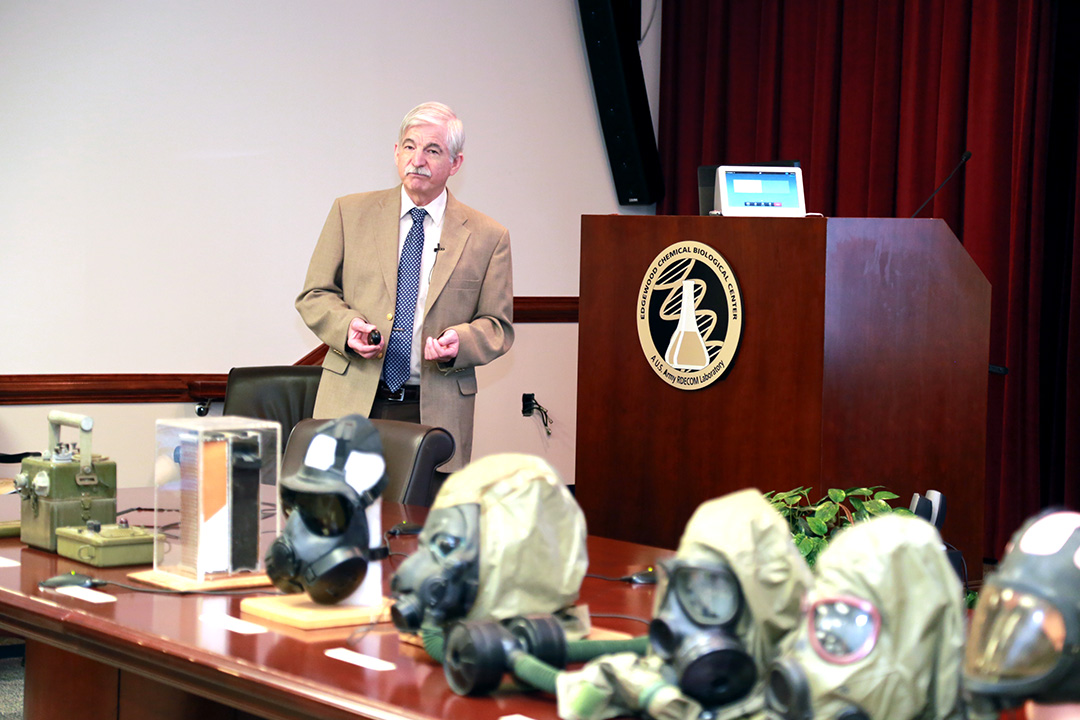// NEWS RELEASE
Historian Sees ECBC’s History as a Story of Innovation
CCDC Chemical Biological Center Public Affairs | May 25th, 2017
Historian Sees ECBC’s History as a Story of Innovation
DEVCOM CBC Public AffairsMay 25th, 2017

Speaking before an overflowing audience, REDECOM Historian Jeff Smart covered material from his recently published book, “A Century of Innovation: The Army's Chemical Biological Defense Program 1917-2017.”
American Soldiers have not had to face chemical or biological weapons in battle since World War I because of the deterrence that comes with having the best protective equipment in the world, according to the U.S. Army Research, Development, and Engineering Command’s (RDECOM) official historian, Jeff Smart.
Speaking before an overflowing audience that spilled out into an adjoining conference room at ECBC’s Berger Auditorium on May 24, he described the centers 100 year history as the continuous reliance on innovation to overcome challenges.
For example, when American Soldiers arrived in France in 1917, the British were using a good protective mask, but one that relied on an uncomfortable mouthpiece and nose clip that made it hard to talk. The British masks also had a tendency to fog the eye lenses making it hard to see. The French developed a non-fogging design, without the mouthpiece and nose clip called the Tissot design, so U.S. mask designers Waldemar Kops and Randolph Monro combined the best features of both designs to come up with the Kops Tissot Monro mask, which started arriving in the trenches in October 1918. This mask was later designated the M1 mask, the first of a long line of masks leading up to today’s M50 protective mask.
The material for Smart’s hour-long lecture came from his recently published book, “A Century of Innovation: The Army’s Chemical Biological Defense Program 1917-2017.” It is a decade-by- decade description of ECBC’s 100-year history. As with his book, Smart’s lecture included ECBC’s most significant inventions and historical context on their importance to the Soldier in the field and the American public.
Smart has been at RDECOM chronicling that history for a full one-third of those 100 years. He completed a Bachelor of Arts and a Master of Arts degree in history at San Jose State University in the late 1970s and early 1980s. While searching for a history job, he ended up working for the Internal Revenue Service for one year and then becoming a special agent with the Defense Investigative Service. “After two years, I finally got my dream job as a historian,” he said. “It was almost 3,000 miles from where I grew up, so I loaded up my car and moved to Bel Air, Maryland.”
“I had been trained as a Civil War historian, so I knew nothing about chemical biological agents or their use in warfare,” he said. “And upon arriving, I discovered that a once thriving historical office on the subject had been shut down in 1977. So, with one assistant, I threw myself into gathering historical photographs, documents, training aids, and Soldiers’ recollections from anywhere I could find them around the country.” Later on, a colleague of his even purchased some of them on eBay.
He now has more than 15,000 photographs and more than 5,000 films and videos catalogued, and more documents than he can count. The collection keeps growing because whenever ECBC closes down a building, he is called in to scour it for anything of historical significance.
His book took a year to write and is the culmination of his decades on the job. “I really hope this book will raise the visibility of ECBC and U.S. chemical biological defense,” he said. “We’re often invisible because of our success, but we must always remain prepared, and that’s a job ECBC deserves credit for.”
Smart’s talk was the second in ECBC’s 100-year anniversary lecture series. The next will be on June 14 by Naomi Halas, Ph.D., director of the Smalley-Curl Institute and founding director of the Laboratory for Nanophotonics at Rice University. She will speak on the future of science. On Aug. 22, Gigi Kwik Gronvall, Ph.D., a senior associate at the Johns Hopkins Center for Health Security, will speak on synthetic biology and bioterrorism. On Oct. 11, Freeman Hrabowski, Ph.D., president of the University of Maryland at Baltimore County, will speak on grassroots innovation. For more information, go to: https://www.cbc.devcom.army.mil/100/ecbc-anniversary-events.html.
The U.S. Army Combat Capabilities Development Command (DEVCOM) leads in the discovery, development and delivery of technology-based capabilities to enable Soldiers to win our nation’s wars and come home safely. DEVCOM is a major subordinate command of the U.S. Army Futures Command. The DEVCOM Chemical Biological Center is the Army’s principal research and development center for chemical and biological defense technology, engineering and field operations. The DEVCOM Chemical Biological Center is headquartered at Aberdeen Proving Ground, Maryland.

